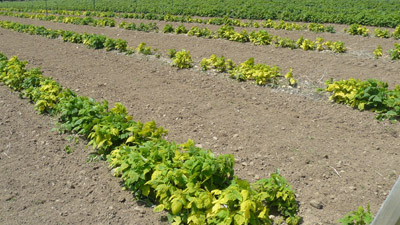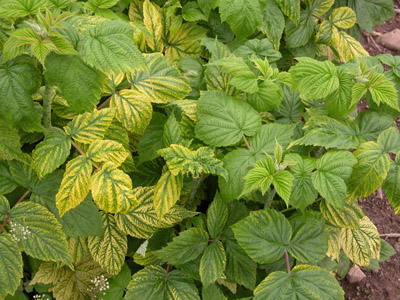Raspberry bushy dwarf virus
Learn how to identify the raspberry bushy dwarf virus (RBDV) and manage its spread.
Do your raspberry plants turn yellow in spring? Do you see apparent symptoms of herbicide injury on emerging primocanes? Is fruit crumbly? These may be symptoms of raspberry bushy dwarf virus, a pollen-born virus that affects red and black raspberries and occurs naturally in wild raspberries.
Raspberry bushy dwarf virus (RBDV) can cause a variety of symptoms, and may cause no symptoms in some cultivars. One common symptom is yellow, interveinal chlorosis on emerging primocanes in the spring (Figure 1 and Figure 2). These symptoms are commonly mistaken for simazine injury. This virus can also cause crumbly fruit, and a reduction in vigour. Leaves may exhibit yellow blotches, rings and lines.


The best way to diagnose raspberry bushy dwarf virus is early in the season, when temperatures are fairly cool and symptoms are most evident. Collect a few young but fully expanded leaves with symptoms and send to a diagnostic laboratory. ELISA test kits have been developed to diagnose this virus and most diagnostic labs will provide this service.
Raspberry bushy dwarf virus is a big problem because it is spread to new plants in pollen from infected raspberry plants. Some varieties are more tolerant than others, and some plant breeders have developed varieties with resistance to this disease. Primocane fruiting varieties are prone to RBDV because of their long bloom period. Management of RBDV includes the following steps:
- Purchase virus-tested plants from an accredited nursery.
- Control wild raspberries around the field and farm.
- Rogue out infested plants.
- Remove bloom in the establishment year of a raspberry planting.
Author's Note: Tomato ringspot virus is another common virus in Ontario raspberries, and the one I see most often. Tomato ringspot virus is spread by the dagger nematode. Symptoms include crumbly fruit, and a reduction plant vigour. This virus can also be diagnosed using the ELISA test.